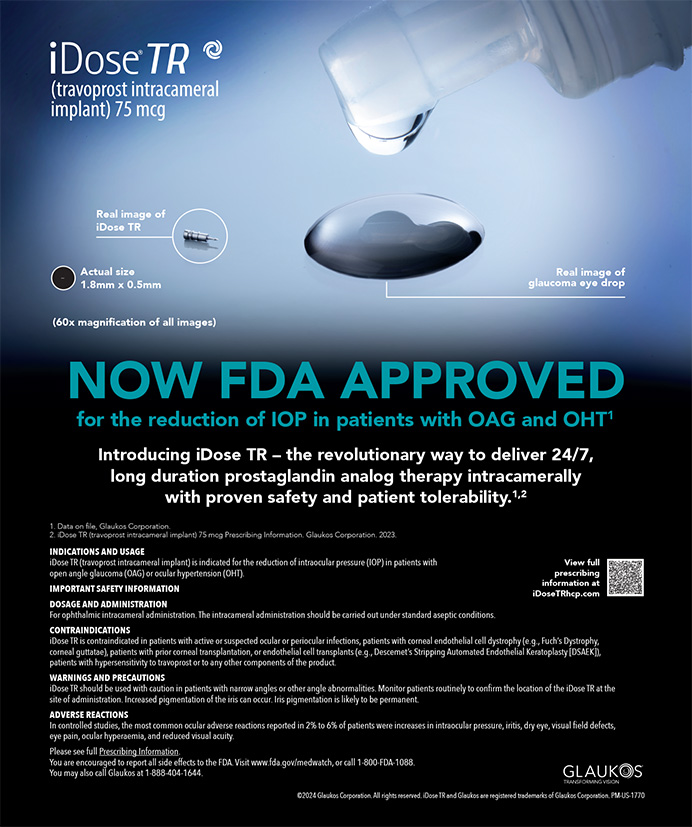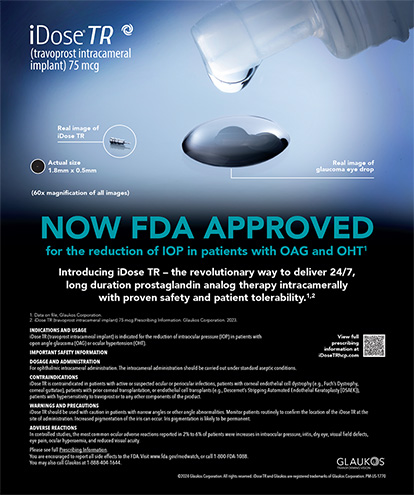Patients seeking refractive surgery who present with no symptoms other than a desire to reduce their dependence on glasses and/or contact lenses commonly have slightly atypical topography. Unfortunately, ophthalmologists cannot be certain that the cornea of someone with normal or atypical topography will stand up to rigors such as rubbing of the eyes, sleeping, exercise, weight lifting, or the loss of the lid's laxity as he ages.1-4 Clinicians use topography in an attempt to predict a patient's future corneal health. Will he develop progressive ectasia later in life? If he would not develop the pathologic condition naturally, will surgery or contact lens wear induce it?5,6
For eyes with atypical topographies, our preferred treatment approach is PRK, which surgeons have used for several years in keratoconus suspects.7 As ophthalmologists, we would like to think that we could infallibly identify eyes that will have progressive ectasia and avoid elective procedures for them, because they will not have stable outcomes. Unfortunately, the degree of false positives and false negatives with topography and the natural history of keratoconus are such that we do not know which eyes are going to have progressive ectasia. Although a small number of these eyes may develop the problem, it does not appear that PRK alters the natural course of the disease to any significant extent.
WHAT CAUSES KERATOCONUS?
Approximately 30 years ago, surgeons debated whether contact lenses caused keratoconus.6 Similarly, they wonder today whether PRK or LASIK causes the disease or whether it would become manifest without surgery.8 Ophthalmologists have no long-term, randomized, prospective studies to support their current clinical impressions of the degree of corneal irregularity that puts a patient at risk for ectasia. Some eyes develop this thinning without any known trauma or surgery,3 and others undergo surgery thought to induce ectasia but with no progression of the disease (Figure 1). As surgeons, we do the best we can to diagnose accurately those at risk despite the variation in topographic abnormalities among patients (Figures 2 and 3).
VARIABLE TOPOGRAPHIC INTERPRETATION
We evaluated the eyes of patients treated from 1998 to 2001 who had undergone LASIK yet had atypical topography and those of patients with a similar age, refractive error, pachymetry, and ablation depth to evaluate the consistency of surgeons' topographic evaluations.9 Six surgeons from around the country reviewed these eyes in a masked fashion and graded them as either normal or abnormal. Of interest was the lack of agreement between the surgeons as to whether a given topography were normal or abnormal and whether they would operate (Table 1). In the eyes with atypical topography, 3 experienced progressive ectasia with LASIK (progression was in one eye with definite keratoconus), which is less than the rate seen in reports of LASIK in more severely affected eyes.10-12 Although our experience in eyes with LASIK and atypical topography did not appear to be significantly different than the natural history of keratoconus, there are now a significant number of anecdotal case reports of ectasia in eyes undergoing LASIK. Most, but not all, have abnormal topography.5
For eyes with atypical topography we have switched to surface ablation, which is especially important with the deeper ablations of wavefront corrections.
OUR EXPERIENCE WITH SURFACE ABLATION
We have retrospectively evaluated eyes that we have treated with PRK that have inferior steepening on topography with coma or trefoil on wavefront testing. Our results to date support our decision to use surface ablation on eyes with atypical topography.
We have performed surface laser ablations with the Visx S4 excimer laser with Customvue (Advanced Medical Optics, Inc., Santa Ana, CA) on 92 eyes that had coma or trefoil of greater than 0.15?m.13 In some eyes, the level of coma was as high as 1.4?m. The mean spherical equivalent in the study eyes was -3.20 ?1.80D, with a mean level of astigmatism of 0.70 ?0.60D. The average level of coma was 0.3 ?0.2?m, and the mean depth of treatment was 60 ?23?m.
In the 54 eyes with 1 year's follow-up, 74 had 20/20 or better UCVA, and 93 had 20/30 or better UCVA. These results are not as successful as in eyes with normal topography that undergo wavefront-guided LASIK, most likely due to the higher amount of preoperative aberrations and astigmatism. Outcomes are likely to improve with iris registration technology.
One patient with coma of 0.23?m and approximately -5.00D of myopia underwent PRK, which reduced the amount of aberration and resulted in 20/15 UCVA (Figure 4).
Another patient with high coma had an ablation depth large enough that our preference was a staged procedure of Intacs (Addition Technology Inc., Des Planes, IL) and conductive keratoplasty (CK; Refractec, Inc., Irvine, CA) first, followed later by PRK. Postoperatively, the topography was more symmetrical, and his UCVA was 20/20 (Figure 5).
CONCLUSION
Overall, our early results with PRK in eyes with atypical topography seem promising. The visual outcomes are good in this group of eyes that have significant aberrations.
In patients with unusual topography or corneal curvature, surgeons have to decide between LASIK, a surface procedure such as PRK or LASEK, IOLs, or no surgical treatment. Although LASIK offers the advantages of a more rapid recovery and less haze, PRK is performed at a shallower region of the cornea and thus potentially offers greater biomechanical stability for patients who may have unusual corneas. IOLs can cause instability of the peripheral cornea and are associated with risks such as cataract formation and intraocular intervention, which in the lower degrees of correction may not have the risk/benefit profile we desire or be as accurae as PRK. For patients with very high degrees of corneal asymmetry, we prefer a staged approach of Intacs and CK first and PRK later. For high corrections, we prefer a staged approach of a phakic IOL or refractive lens exchange followed by PRK or Intacs and CK.
When treating eyes with atypical topography, ophthalmologists must recognize that they currently cannot predict whether an individual cornea will develop progressive ectasia with or without surgical intervention. Certainly, some will develop progressive ectasia even without surgery. We would like to be able to determine the relative risk for an individual patient for long-term refractive stability without surgery, with PRK, or with LASIK; unfortunately, this information is not available. Surgeons should continue to do their best to help patients predict the future for their eyes with and without surgery. We believe that PRK minimally increases the risk for the patient with atypical topography.
David R. Hardten, MD, is Director of Refractive Surgery for Minnesota Eye Consultants in Minneapolis. He is a consultant to Advanced Medical Optics, Inc., and TLCVision. He performs research for Alcon Laboratories, Inc., Advanced Medical Optics, Inc., and STAAR Surgical Company. Dr. Hardten may be reached at (612) 813-3600; drhardten@mneye.com.
Vrushali V. Gosavi, MD, is a research fellow at Minnesota Eye Consultants. She acknowledged no financial interest in the products or companies mentioned herein. Dr. Gosavi may be reached at (612) 813-3600.
By John A. Vukich, MD
I recently conducted a database search and retrieved more than 150 journal articles that cited a link between ectasia and LASIK or PRK. After a careful review of 138 total case reports of ectasia, I found that 108 of them contained adequate information on the residual thickness of the corneal bed to allow for further analysis.1-35 Although it is commonly thought that a residual corneal bed thickness of 250?m is sufficient to maintain stability, of the corneas that developed postoperative ectasia, 59.3 (64 of the 108 cases) had a residual corneal bed of more than 250?m, and 34.3 (37 cases) had greater than 300?m.
It is becoming increasingly clear that the safe thickness of the corneal bed varies and may exceed what we surgeons held to be the absolute minimum. Many of the aforementioned cases had preexisting keratoconus/forme fruste keratoconus or abnormal topography preoperatively. Some, however, involved none of the apparent risk factors for ectasia (eg, thin cornea, abnormal topography, etc), yet the eyes in question still developed the disease (Figures 1 and 2).
We regularly are faced with the decision of how to treat a patient with a suspicious cornea. The option of forgoing the LASIK flap and instead performing a surface treatment to preserve corneal tissue is thought by many to be a more conservative choice. Unfortunately, the relative safety of surface ablation has been called into question by at least two published reports of ectasia following PRK.1,27 In cases in which the cornea is suspect, I have come to the conclusion that, rather than treat the cornea with surface ablation, the more conservative option is to leave the cornea alone and instead use the Visian Implantable Collamer Lens (ICL; STAAR Surgical Company, Monrovia, CA) (Figure 3).
TREATMENT OPTION FOR A SUSPICIOUS CORNEA
I believe that ophthalmologists are beginning to select refractive IOL surgery rather than laser refractive surgery for patients who have corneas of questionable thickness, irregular topography, or suspicious features. Implanting the Visian ICL eliminates any question of how much or aggressively we can alter the cornea without compromising its structural stability. The rapid speed of recovery, high optical quality, and patients' satisfaction with phakic IOLs have been well documented. If patients are given a choice of a prolonged healing time with PRK or an almost instant recovery of vision with the Visian ICL, I think the phakic IOL will win every time. If we further weigh the potential risk of ectasia that has now been associated with PRK in suspicious corneas, I think the conservative approach to medical decision making also favors the use of an ICL.
CONCLUSION
The medicolegal consequence of failing to identify patients with corneas that are at risk of adverse outcomes such as postoperative ectasia is becoming clear. Several judgments in excess of $1 million have brought this issue to the attention of refractive surgeons as well as the legal profession.36,37 The result is that our assessments of patients' suitability for corneal refractive surgery will come under increasing scrutiny. Patients will become more likely to question our decisions, and lawyers will be more willing to pursue judgments if ectasia develops.
LASIK remains an excellent procedure with outstanding outcomes. Occasionally, we will identify patients with irregular topography or suspicious features that will make us consider alternatives. If the preoperative evaluation makes us consider PRK, I believe it is best to leave the cornea alone and to use an ICL to correct the refractive error. Phakic IOLs eliminate the need to alter the cornea and may offer an added margin of safety for patients with preoperatively suspicious corneas.
John A. Vukich, MD, is Assistant Clinical Professor at the University of Wisconsin, Madison. He is a paid consultant for STAAR Surgical Company. Dr. Vukich may be reached at (608) 282-2002; javukich@facstaff.wisc.edu..


